Legs in a fly pupa are tightly
folded in Z-configuration: the femur points forward. The fly emerges
from the pupa with all legs stretched backwards. How does the
fly turn long femora inside the tight puparium? Flies were captured
during emergence at various moments of progress out of the puparium
and at once fixed in ethanol, postfixed in Bouin's solution. Specimens
were ranged by the grade of progressive extrication and maturation.
Legs were excised, their configurations photographed. Legs are
anchored to the VIII. abdominal segment of the puparium with the
pupal sheath. Some podomers were arched or buckled yet in pharate
adults. At the initial moment of extrication, new buckles appeared
in femora, they split femora into 2e3 subpodomers. Instead of
turning the whole femur, the fly dragged through the puparium
a chain of short subpodomers linked together with transient hinges.
Hinges emerged in unsclerotized areas of the tubular podomer,
close to sclerotized areas (juvenile sclerites). During extrication,
legs were stretched passively. This process lasted for 1-3 min,
initial phase Ц few seconds. Residual distortions were left in
hind legs of free juvenile adults. Mechanics of buckling and straightening
is discussed from the viewpoint of strength of materials.
Stages of metamorphosis in Calliphora vicina
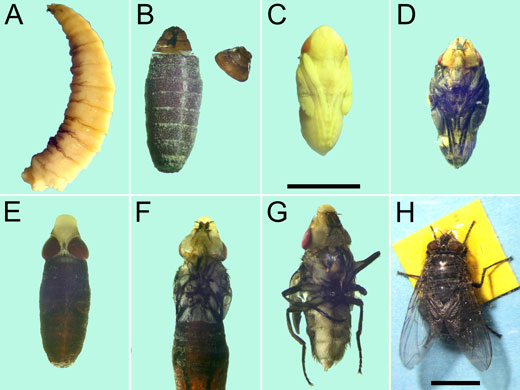
(A) postfeeding larva; (B) empty puparium with
parted valves; (C) pharate pupa; (D) pharate imago; (E) early
stage of extrication, the big ptilinium is prominent; (F) late
stage of extrication; (G) juvenile adult, able to walk; (H)
mature live adult, consuming a honey drop.
Metamorphosis lasts for 10 days, extrication
outside of the soil Ц only 1-3 minutes. Details are not seen
inside an opaque confinement. Therefore, we fixed insects at
different moments of eclosion and ranked them by their advance
out of puparium.
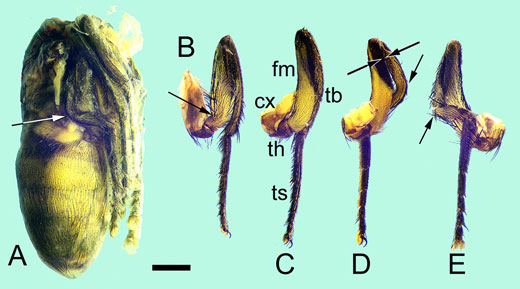
Legs in the pharate adult are compactly packed
in the zigzag configuration. (A) The pupa with the adult
inside, excised from the puparium. The head and wings removed,
view at the right body side. Black and white arrow indicates
bending of the hind tibia about the right angle. (B-E) Configurations
of separate legs: front (B), middle (C), and hind (D, E). (B-D)
rear view, (E) front view. Podomers are indicated in (C): cx
Ц coxa, th Ц trochanter, fm Ц femur, tb Ц tibia, ts Ц tarsus.
The black arrow in (B) indicates the juvenile basal hinge in
the femur, in (D, E) Ц arching of the tibia, arrows with white
shades in (D) indicate juvenile sclerites: the distal one in
the femur, the proximal one in the tibia. Scale bar 1 mm.
Flies get out of their puparia with straigtened
legs, for this purpose they must turn the femur about 90°.
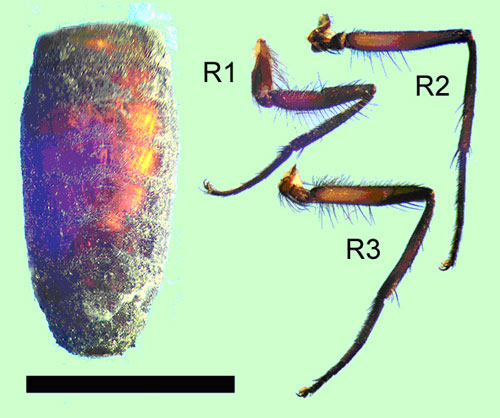
Compare the size of the puparium of a blowfly
with the adult legs of the same fly: the leg has only scarce
space for such maneuvres.
The fly does not turn its femora, but fractures
them in pieces. These subpodomeres are joined with bucklings
which function like transient hinges: they may flex and extend.
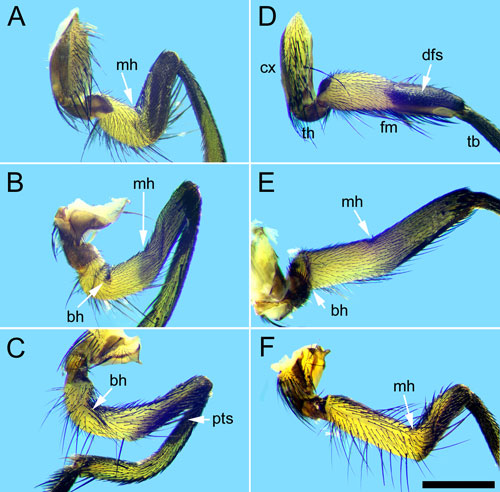
Details of leg deformations in extricating
flies. (A-C) legs of the specimen of early rank 3; (D-F)
legs of one specimen of late rank 8. (A, D) left front legs,
front view; (B, E) right middle legs, rear view; (D, F) left
hind legs, front view. Abbreviations: bh Ц basal femoral hinge,
cx Ц coxa, fm Ц femur, mh Ц medial femoral hinge, tb Ц tibia,
th - trochanter. Sclerotized parts of long podomeres are indicated
in (D): dfs Ц distal femoral sclerite, and in (C): pts Ц proximal
tibial sclerite. Scale bar 1 mm.
Instead of impossible turning of the femur about
a blunt angle, the fly splits the femur in 2-3 transient subpodomeres
and pulls the chain of short subpodomeres through the tight
space inside the puparium. Later on, this chain is straightened,
as well as the initially curved hind tibia.
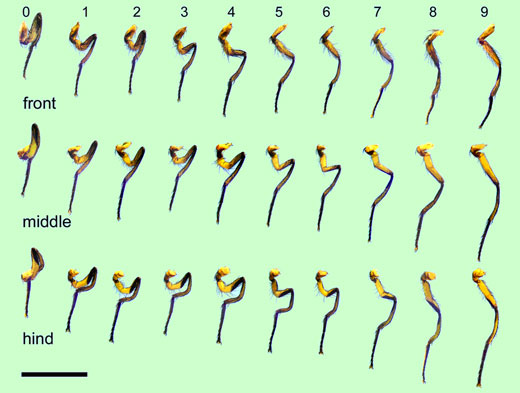
Change of the leg configuration versus the
progress of extrication. (Top row) front legs, (middle row)
middle legs, (bottom row) hind legs. Legs were excised in 16
specimens and arranged in the rank order. Ranks 0 to 9 from
the pharate imago to the free one are indicated above. Rear
view. Scale bar 5 mm.
Buckling and stretching are applied to the legs
passively, from the side of the imaginal trunk moving ahead
by peristaltic bouts.
Reparation of residual leg deformations occurs
during 1-2 hours of expansion and hardening (tanning) of the
cuticle of an adult fly.



